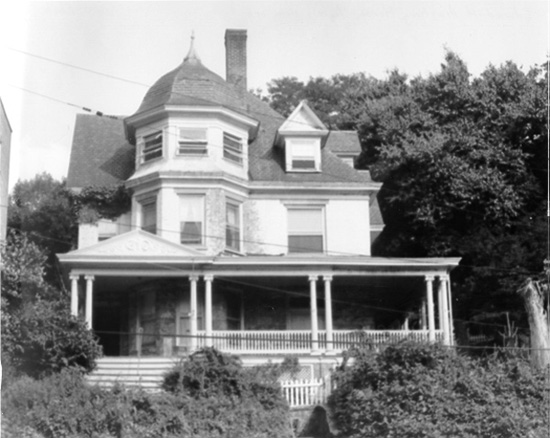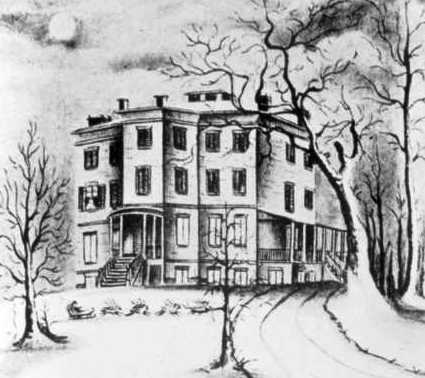|
Edwin Howard Armstrong
Edwin Howard Armstrong (December 18, 1890 – February 1, 1954) was an American electrical engineer and inventor, who developed FM (frequency modulation) radio and the superheterodyne receiver system. He held 42 patents and received numerous awards, including the first Medal of Honor awarded by the Institute of Radio Engineers (now IEEE), the French Legion of Honor, the 1941 Franklin Medal and the 1942 Edison Medal. He was inducted into the National Inventors Hall of Fame and included in the International Telecommunication Union's roster of great inventors. Armstrong attended Columbia University, and served as a professor there for most of his life. Early life Armstrong was born in the Chelsea district of New York City, the oldest of John and Emily (née Smith) Armstrong's three children. His father began working at a young age at the American branch of the Oxford University Press, which published bibles and standard classical works, eventually advancing to the positio ... [...More Info...] [...Related Items...] OR: [Wikipedia] [Google] [Baidu] |
Chelsea, Manhattan
Chelsea is a neighborhood on the West Side of the borough of Manhattan in New York City. The area's boundaries are roughly 14th Street to the south, the Hudson River and West Street to the west, and Sixth Avenue to the east, with its northern boundary variously described as near the upper 20sRegier, Hilda. "Chelsea (i)" in , pp.234-235 or 34th Street, the next major crosstown street to the north.Navarro, Mireya"In Chelsea, a Great Wealth Divide", ''The New York Times'', October 23, 2015. Accessed October 23, 2015. "Today's Chelsea, the swath west of Sixth Avenue between 14th and 34th Streets, could be the poster neighborhood for what Mayor Bill de Blasio calls the tale of two cities." To the northwest of Chelsea is the neighborhood of Hell's Kitchen, as well as Hudson Yards; to the northeast are the Garment District and the remainder of Midtown South; to the east are NoMad and the Flatiron District; to the southwest is the Meatpacking District; and to the south and ... [...More Info...] [...Related Items...] OR: [Wikipedia] [Google] [Baidu] |
Superheterodyne Receiver
A superheterodyne receiver, often shortened to superhet, is a type of radio receiver that uses frequency mixing to convert a received signal to a fixed intermediate frequency (IF) which can be more conveniently processed than the original carrier frequency. It was long believed to have been invented by US engineer Edwin Armstrong, but after some controversy the earliest patent for the invention is now credited to French radio engineer and radio manufacturer Lucien Lévy. Virtually all modern radio receivers use the superheterodyne principle; except those software-defined radios using ''direct sampling''. History Heterodyne Early Morse code radio broadcasts were produced using an alternator connected to a spark gap. The output signal was at a carrier frequency defined by the physical construction of the gap, modulated by the alternating current signal from the alternator. Since the output frequency of the alternator was generally in the audible range, this produces an aud ... [...More Info...] [...Related Items...] OR: [Wikipedia] [Google] [Baidu] |
Edison Medal
The IEEE Edison Medal is presented by the Institute of Electrical and Electronics Engineers (IEEE) "for a career of meritorious achievement in electrical science, electrical engineering, or the electrical arts." It is the oldest medal in this field of engineering. The award consists of a gold medal, bronze replica, small gold replica, certificate, and honorarium. The medal may only be awarded to a new leap/breakthrough in the technological area of science. Background The Edison Medal, named after the inventor and entrepreneur Thomas Edison, was created on 11 February 1904 by a group of Edison's friends and associates. Four years later the American Institute of Electrical Engineers (AIEE) entered into an agreement with the group to present the medal as its highest award. The first medal was presented in 1909 to Elihu Thomson. Other recipients of the Edison Medal include George Westinghouse, Alexander Graham Bell, Nikola Tesla, Michael I. Pupin, Robert A. Millikan (Nobel Pri ... [...More Info...] [...Related Items...] OR: [Wikipedia] [Google] [Baidu] |
Legion Of Honor
The National Order of the Legion of Honour (french: Ordre national de la Légion d'honneur), formerly the Royal Order of the Legion of Honour ('), is the highest French order of merit, both military and civil. Established in 1802 by Napoleon Bonaparte, it has been retained (with occasional slight alterations) by all later French governments and regimes. The order's motto is ' ("Honour and Fatherland"); its seat is the Palais de la Légion d'Honneur next to the Musée d'Orsay, on the left bank of the Seine in Paris. The order is divided into five degrees of increasing distinction: ' ( Knight), ' (Officer), ' ( Commander), ' (Grand Officer) and ' ( Grand Cross). History Consulate During the French Revolution, all of the French orders of chivalry were abolished and replaced with Weapons of Honour. It was the wish of Napoleon Bonaparte, the First Consul, to create a reward to commend civilians and soldiers. From this wish was instituted a , a body of men that was not an ord ... [...More Info...] [...Related Items...] OR: [Wikipedia] [Google] [Baidu] |
IEEE
The Institute of Electrical and Electronics Engineers (IEEE) is a 501(c)(3) professional association for electronic engineering and electrical engineering (and associated disciplines) with its corporate office in New York City and its operations center in Piscataway, New Jersey. The mission of the IEEE is ''advancing technology for the benefit of humanity''. The IEEE was formed from the amalgamation of the American Institute of Electrical Engineers and the Institute of Radio Engineers in 1963. Due to its expansion of scope into so many related fields, it is simply referred to by the letters I-E-E-E (pronounced I-triple-E), except on legal business documents. , it is the world's largest association of technical professionals with more than 423,000 members in over 160 countries around the world. Its objectives are the educational and technical advancement of electrical and electronic engineering, telecommunications, computer engineering and similar disciplines. History Ori ... [...More Info...] [...Related Items...] OR: [Wikipedia] [Google] [Baidu] |
Superheterodyne
A superheterodyne receiver, often shortened to superhet, is a type of radio receiver that uses frequency mixing to convert a received signal to a fixed intermediate frequency (IF) which can be more conveniently processed than the original carrier frequency. It was long believed to have been invented by US engineer Edwin Armstrong, but after some controversy the earliest patent for the invention is now credited to French radio engineer and radio manufacturer Lucien Lévy. Virtually all modern radio receivers use the superheterodyne principle; except those software-defined radios using ''direct sampling''. History Heterodyne Early Morse code radio broadcasts were produced using an alternator connected to a spark gap. The output signal was at a carrier frequency defined by the physical construction of the gap, modulated by the alternating current signal from the alternator. Since the output frequency of the alternator was generally in the audible range, this produces an audible a ... [...More Info...] [...Related Items...] OR: [Wikipedia] [Google] [Baidu] |
Frequency Modulation
Frequency modulation (FM) is the encoding of information in a carrier wave by varying the instantaneous frequency of the wave. The technology is used in telecommunications, radio broadcasting, signal processing, and Run-length limited#FM: .280.2C1.29 RLL, computing. In Analog signal, analog frequency modulation, such as radio broadcasting, of an audio signal representing voice or music, the instantaneous frequency deviation, i.e. the difference between the frequency of the carrier and its center frequency, has a functional relation to the modulating signal amplitude. Digital data can be encoded and transmitted with a type of frequency modulation known as frequency-shift keying (FSK), in which the instantaneous frequency of the carrier is shifted among a set of frequencies. The frequencies may represent digits, such as '0' and '1'. FSK is widely used in computer modems, such as fax modems, telephone caller ID systems, garage door openers, and other low-frequency transmissions. R ... [...More Info...] [...Related Items...] OR: [Wikipedia] [Google] [Baidu] |
Electrical Engineer
Electrical engineering is an engineering discipline concerned with the study, design, and application of equipment, devices, and systems which use electricity, electronics, and electromagnetism. It emerged as an identifiable occupation in the latter half of the 19th century after commercialization of the electric telegraph, the telephone, and electrical power generation, distribution, and use. Electrical engineering is now divided into a wide range of different fields, including computer engineering, systems engineering, power engineering, telecommunications, radio-frequency engineering, signal processing, instrumentation, photovoltaic cells, electronics, and optics and photonics. Many of these disciplines overlap with other engineering branches, spanning a huge number of specializations including hardware engineering, power electronics, electromagnetics and waves, microwave engineering, nanotechnology, electrochemistry, renewable energies, mechatronics/control, an ... [...More Info...] [...Related Items...] OR: [Wikipedia] [Google] [Baidu] |
Washington Award
The Washington Award is an American engineering award. Since 1916 it has been given annually for "accomplishments which promote the happiness, comfort, and well-being of humanity". It is awarded jointly by the following engineering societies: American Institute of Mining, Metallurgical, and Petroleum Engineers, American Nuclear Society, American Society of Civil Engineers, American Society of Mechanical Engineers, Institute of Electrical and Electronics Engineers, National Society of Professional Engineers, and Western Society of Engineers (which administers the award). Honorees SourceThe Washington Award* Herbert C. Hoover, 1919 * Robert W. Hunt, 1922 * Arthur N. Talbot, 1924 * Jonas Waldo Smith, 1925 * John Watson Alvord, 1926 * Orville Wright, 1927 * Michael Idvorsky Pupin, 1928 * Bion Joseph Arnold, 1929 * Mortimer Elwyn Cooley, 1930 * Ralph Modjeski, 1931 * William David Coolidge, 1932 * Ambrose Swasey, 1935 * Charles Franklin Kettering, 1936 * Frederick G ... [...More Info...] [...Related Items...] OR: [Wikipedia] [Google] [Baidu] |
IEEE Edison Medal
The IEEE Edison Medal is presented by the Institute of Electrical and Electronics Engineers (IEEE) "for a career of meritorious achievement in electrical science, electrical engineering, or the electrical arts." It is the oldest medal in this field of engineering. The award consists of a gold medal, bronze replica, small gold replica, certificate, and honorarium. The medal may only be awarded to a new leap/breakthrough in the technological area of science. Background The Edison Medal, named after the inventor and entrepreneur Thomas Edison, was created on 11 February 1904 by a group of Edison's friends and associates. Four years later the American Institute of Electrical Engineers (AIEE) entered into an agreement with the group to present the medal as its highest award. The first medal was presented in 1909 to Elihu Thomson. Other recipients of the Edison Medal include George Westinghouse, Alexander Graham Bell, Nikola Tesla, Michael I. Pupin, Robert A. Millikan (Nobel Pri ... [...More Info...] [...Related Items...] OR: [Wikipedia] [Google] [Baidu] |
Franklin Medal
The Franklin Medal was a science award presented from 1915 until 1997 by the Franklin Institute located in Philadelphia, Pennsylvania, U.S. It was founded in 1914 by Samuel Insull Samuel Insull (November 11, 1859 – July 16, 1938) was a British-born American business magnate. He was an innovator and investor based in Chicago who greatly contributed to create an integrated electrical infrastructure in the United States .... The Franklin Medal was the most prestigious of the various awards presented by the Franklin Institute. Together with other historical awards, it was merged into the Benjamin Franklin Medal, initiated in 1998. Laureates Recipients are listed in a database on The Franklin Institute website. References {{reflist, 30em External links The Franklin Institute Awards Franklin Institute awards ... [...More Info...] [...Related Items...] OR: [Wikipedia] [Google] [Baidu] |
Holley Medal
The Holley Medal is an award of ASME (the American Society of Mechanical Engineers) for "outstanding and unique act(s) of an engineering nature, accomplishing a noteworthy and timely public benefit by one or more individuals for a single achievement, provided the contributions are equal or comparable."Holley Medal - ASME at ''asme.org.'' Accessed 08-05-2017 The award was established in 1924 in honor of the American mechanical engineer, inventor and charter member of ASME (1832-1888). |




